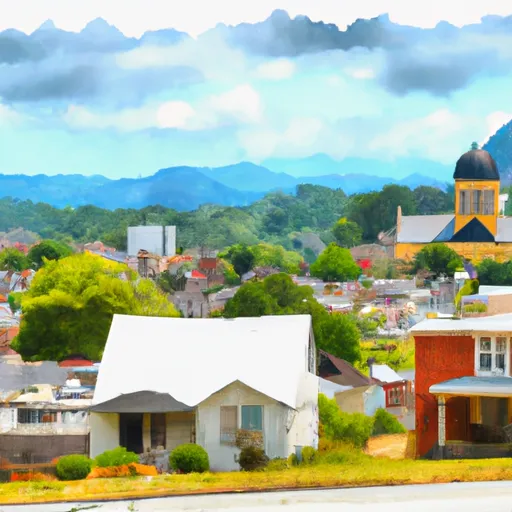-
 Snoflo Premium
Snoflo Premium
Get unlimited access to all our content
With no Ad interruptions! - Start Your Free Trial Login with existing account
Trion
Eden Index
Climate
7.7
•
Recreation
2.5
•
Community
2.1
•
Safeguard
4.5/10

Trion, Georgia is a small town located in Chattooga County, in the northwest corner of the state. The climate in Trion is characterized as humid subtropical, with hot summers and mild winters. Average temperatures range from the high 80s in summer to the low 40s in winter, making it a pleasant place to live or visit year-round.
Trion benefits from its location near the Chattooga River, which provides ample hydrological opportunities. The river offers excellent fishing opportunities, with various species such as trout, bass, and catfish. Additionally, the river is a popular spot for kayaking, canoeing, and rafting, attracting outdoor enthusiasts from all around.
Trion also boasts several other outdoor recreation opportunities. The nearby Chattahoochee National Forest offers hiking trails, camping areas, and breathtaking scenic views. The pocket wilderness areas offer a unique experience for nature lovers. The city is also home to several parks and recreational facilities, providing opportunities for sports, picnics, and family outings.
In conclusion, Trion, Georgia offers a favorable climate, access to the beautiful Chattooga River, and a range of outdoor recreational activities. Whether it's fishing, water sports, hiking, or simply enjoying nature, Trion provides ample opportunities for outdoor enthusiasts to indulge in their favorite activities.
What is the Eden Index?
The Snoflo Eden Index serves as a comprehensive rating system for regions, evaluating their desirability through a holistic assessment of climate health, outdoor recreation opportunities, and natural disaster risk, acknowledging the profound impact of these factors on livability and well-being.
Climate Health Indicator (CHI): 7.7
Trion receives approximately
1385mm of rain per year,
with humidity levels near 85%
and air temperatures averaging around
16°C.
Trion has a plant hardyness factor of
7, meaning
plants and agriculture in this region tend to thrive during the non-winter months.
By considering the ideal temperature range, reliable water supplies, clean air, and stable seasonal rain or snowpacks, the Climate Health Indicator (CHI) underscores the significance of a healthy climate as the foundation for quality living.
A healthy climate is paramount for ensuring a high quality of life and livability in a region, fostering both physical well-being and environmental harmony. This can be characterized by ideal temperatures, reliable access to water supplies, clean air, and consistent seasonal rain or snowpacks.
Weather Forecast
Streamflow Conditions
Coosa-Tallapoosa
Area Rivers
Coosa-Tallapoosa
Snowpack Depths
Coosa-Tallapoosa
Reservoir Storage Capacity
Coosa-Tallapoosa
Groundwater Levels
Recreational Opportunity Index (ROI): 2.5
The Recreational Opportunity Index (ROI) recognizes the value of outdoor recreational options, such as parks, hiking trails, camping sites, and fishing spots, while acknowledging that climate plays a pivotal role in ensuring the comfort and consistency of these experiences.
Access to outdoor recreational opportunities, encompassing activities such as parks, hiking, camping, and fishing, is crucial for overall well-being, and the climate plays a pivotal role in enabling and enhancing these experiences, ensuring that individuals can engage in nature-based activities comfortably and consistently.
Camping Areas
| Campground | Campsites | Reservations | Toilets | Showers | Elevation |
|---|---|---|---|---|---|
| Chewacla State Park | None | 516 ft | |||
| Amity | None | 689 ft | |||
| R Shaefer Heard | None | 640 ft | |||
| LakePoint State Park | 192 | 208 ft | |||
| Spring Villa Campground | 24 | 604 ft | |||
| John Tanner State Park | None | 1,094 ft | |||
| Whitetail Ridge | None | 694 ft | |||
| Pyne Road Park | 24 | 711 ft | |||
| Burnt Village | 120 | 687 ft | |||
| Blanton Creek Park | 50 | 561 ft |
Nearby Ski Areas
Catastrophe Safeguard Index (CSI):
The Catastrophe Safeguard Index (CSI) recognizes that natural disaster risk, encompassing floods, fires, hurricanes, and tornadoes, can drastically affect safety and the overall appeal of an area.
The level of natural disaster risk in a region significantly affects safety and the overall livability, with climate change amplifying these risks by potentially increasing the frequency and intensity of events like floods, fires, hurricanes, and tornadoes, thereby posing substantial challenges to community resilience and well-being.
Community Resilience Indicator (CRI): 2.1
The Community Resilience Indicator (CRI) recognizes that education, healthcare, and socioeconomics are crucial to the well-being of a region. The CRI acknowledges the profound impact of these elements on residents' overall quality of life. By evaluating educational resources, healthcare accessibility, and economic inclusivity, the index captures the essential aspects that contribute to a thriving community, fostering resident satisfaction, equity, and social cohesion.

